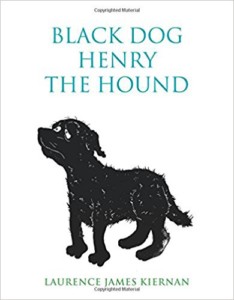 Title: Black Dog Henry the Hound
Title: Black Dog Henry the Hound
Author: Laurence James Kiernan
Publisher: XlibrisAU
ISBN: 978-1-5434-0335-0
Pages: 24
Genre: Self-Help, Family & Relationships
Reviewed by: Barbara Miller
Pacific Book Review
What initially appears as possibly a children’s illustrated story book because of having the title Black Dog Henry the Hound along with a rather whimsical drawing – is anything but a lullaby fantasy. It is a book about the harsh, stark reality of depression in children, as candidly written by Laurence James Kiernan.Segmented into three parts, the first part is a personal reveal of the author’s qualifications to be read only by the parents of a teen or young adult suffering from depression. In it he explains his own near-death experience, and how he was saved along with the love and support of his wife and four daughters. Kiernan modestly and humbly postures himself as not having any professional training in psychology, yet with his decades of real-life experiences coupled with the raising of his daughters, he has learned the symptoms and best ways to deal with the devastation of adolescent depression – having suicide often as a result. There is no doubt he only wishes to help others; many before it is too late.
The second chapter is intended to be read by the entire family in which there is someone in need of his advice. In this chapter, Kiernan uses the Black Dog as a symbol of a devilish entity, a hallucination if you will, seen only by the person suffering from depression. It is a rather gutsy reveal of symptoms and behavior patterns – if and when experienced, will result in a proper diagnostic acknowledgement of deeply rooted depression. It is a red-flag that something needs to be done – and fast! The story reads like an abstract The Twilight Zone episode where this imaginary ugly dog talks to the person with a variety of insults and defamatory remarks.
Lastly Kiernan closes with some additional advice for how to combat this mental disorder. He discusses the timeframes in which results should be expected to have an impact. He provides hotline information and services which are available – albeit in Australia – but nevertheless similar services can be sought in other countries as well.
This book is a must for families not knowing why behavior has changed in their children – or themselves. Loss or changes of appetite, lack of interest, consistent sadness are all clear signs that Black Dog Henry the Hound is talking to you! It is important to heed its warning. Bringing Henry into the story is a valid way to partition the patient from the disorder without saying “you are depressed” in a first-person way. This is a cleaver and practical way to begin the help which is necessary. Understanding the problem, identifying it, and not becoming overwhelmed are the best ways to begin to solve the issue. Although Black Dog Henry the Hound is intended to a narrow audience, its general understanding by a wide variety of readers will enlighten them to the deepening and dark world of depression. If this book saves just one person’s life, Kiernan will delight in the success of his ambitious work.

